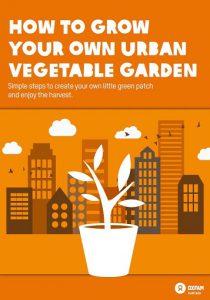Living in a city doesn’t mean you can’t enjoy the great outdoors. With a little imagination, you can cultivate nature within your local environment.
Creating and maintaining an urban garden is much easier than you may think. Like most things, it requires dedication, skill and a little creativity in making the most of the space. Let’s get our hands dirty!
Download eBook: How to Grow Your Own Urban Vegetable Garden

Want to get started building an urban garden?
Find a suitable space with plenty of light
The beauty of urban gardens is that they can adapt to any place or space, however small it may be. You just have to be creative and make the most of the space that’s available.
Sunlight is essential for an urban garden to grow though, so find a space that receives plenty of direct sunlight. This is essential for your plants to grow and develop properly.
Different plants also have different sunlight requirements, so the amount of sunlight your garden receives will determine which plants you can plant.
Don’t have enough outdoor space? Don’t be disheartened! Your urban garden doesn’t need to be outside, so long as you have a sunny window (or two)! Vertical gardens are also ideal if you want to grow in indoor spaces – all you need is a blank wall that gets decent sunlight and you can successfully grow a vertical garden inside your home.
At your local gardening supply store, you’ll find containers, racks and planters of all shapes and sizes that can house your plants. Better still, why not recycle boxes, crates or plastic bottles to personalise your urban garden? Our blog how to make a greenhouse from recycled materials can help!

Pick the right fruits and vegetables for the season
A plant and transplant calendar will help you grow the right plants, according to the season.
If you want to grow spinach or peas in your garden, you’d better get started in March, whereas you should wait until September before you start growing cucumbers or carrots. Get your hands on a comprehensive calendar by downloading our free eBook, How to grow your own urban vegetable garden.
We also recommend planning for crop rotation and making sure your plants have enough room to grow – both upward and deep into the soil.

Select a substrate
Whether it is tomatoes, zucchini, or eggplants, there are few limits to what you can achieve with your veggie patch. But before your fruits and veggies are ready to grow, you need a soil base, which fosters healthy plant growth.
City soil is usually not ideal for gardening, and can have high clay or sand content. We suggest readying the soil with a substrate before planting. One of the most common types of substrates is multi-purpose soil, which can easily be found at your nearest gardening or hardware store. To boost the impact of the substrate, add compost to the mix. Compost is rich in nutrients, and you can make it yourself from kitchen vegetable scraps and garden leaves, twigs and grass.
A good substrate will give your plants all the necessary nutrients and to grow strong and healthy. Download our eBook to learn how to pick the right substrate for your crop.

Water management
When you start growing your own vegetable garden, you have to be careful with watering — it’s very easy to overdo it. Don’t worry; it’s a common mistake for first-timers! Too much water can flush out the soil’s nutrients, leaving the plants without enough food. Every plant has different water requirements. To avoid overwatering, try growing plants that need a similar amount of water next to each other.
In addition to the joy of literally reaping the fruits of your efforts, an urban garden has important rewards for the environment. Urban gardens and orchards significantly reduce your carbon footprint and help Mother Nature fight back against the wasteful practices of big corporations. Using recycled plastics to construct your urban garden will also limit your household waste.

Grow your own urban vegetable garden
Download our free eBook and learn the simple steps to create your own little green patch and enjoy the delicious harvest.
Download guide